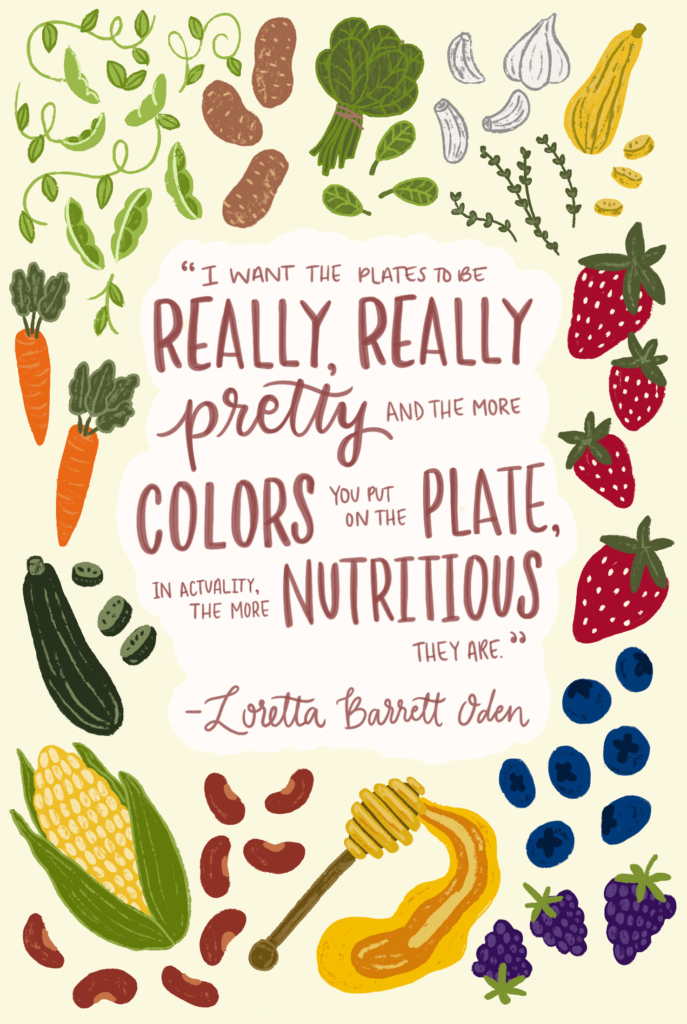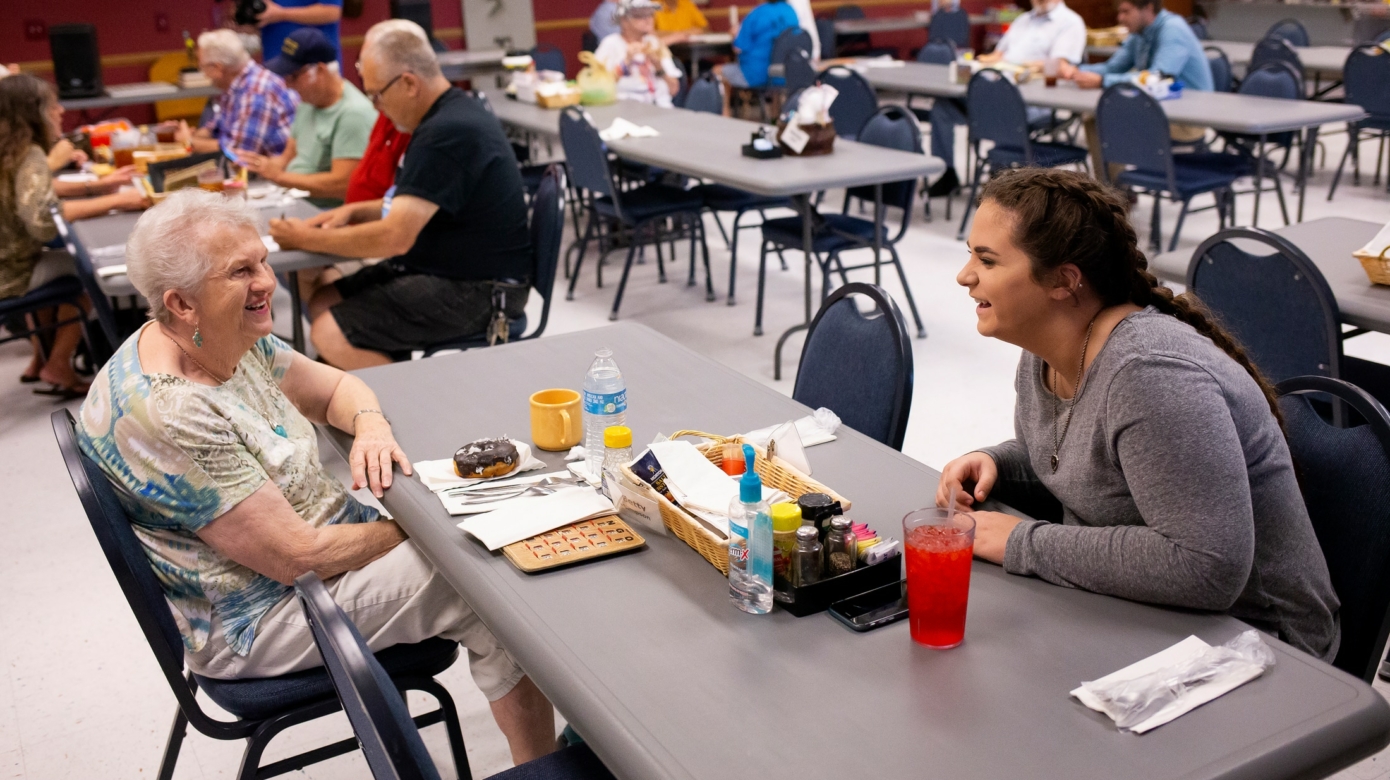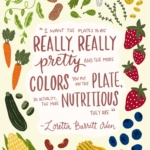March is National Nutrition Month, and it presents the opportunity to reconsider what constitutes a healthy diet and bodily well-being on a wider level. Many of Citizen Potawatomi Nation’s social and health services offer guidance on nutrition at almost every stage of life, as well as programs that feed participants healthy meals.
The Hownikan spoke with CPN’s Women, Infants and Children program on the latest advice for pregnant and breastfeeding women as well as how to get a picky toddler to eat their broccoli. A Tribal member discusses the challenges of offering nutritious foods in a restaurant setting, and the CPN Title VI Program offers elders options while meeting new nutritional needs that come with age.
WIC and nutrition
Healthy nutrition plays an important role throughout pregnancy, and the need to maintain a healthy diet continues after the baby is born.
CPN’s Women, Infants and Children program provides nutritious foods for both mothers and children. WIC recommends low-fat and high-fiber foods — with many of those nutrients found in milk, cereal, eggs, peanut butter and beans — plus fruits, vegetables and whole grains.
The program also provides referrals, health and nutrition education, and nutrition and breastfeeding counseling to eligible pregnant, breast-feeding and postpartum women as well as infants and children age 5 and younger. Their staff includes registered dieticians and lactation consultants to help guide mothers on a healthy path for themselves and their children.
Expectant mothers
Sometimes expectant mothers think they should double their food intake, but this is a common myth.
“Pregnant women are definitely not eating for two,” said Cheryl Richardson, WIC nutrition and breastfeeding coordinator. “They may need a lot more nutrients, but only about 300 extra calories.”
Mothers-to-be receive iron-fortified cereal through WIC, whole wheat bread or another whole grain option as well as reduced fat, low fat or skim milk and allowed cheese substitutions. Eggs, peanut butter, and dried or canned beans or peas satisfy protein requirements. The program also offers cash value benefits for fruits and vegetables.
Nursing mothers
Breastfeeding mothers should continue to be selective about their food choices, focusing on nutrient-rich vegetables and fruits. WIC provides them a cash value benefit for those, plus a larger amount of milk and protein as part of the Special Supplemental Nutrition Program.
“Right now, we have an increased fruits and vegetable cash value benefit, and breastfeeding women get the most cash value benefit,” Richardson said.
Babies qualify for iron-fortified cereal and baby food fruits, vegetables and meats.
WIC gives breastfeeding women nutritional tips and encourages them to listen to their doctors’ advice and continue to take prenatal vitamins even after the baby is born.
Mothers who are breastfeeding for the first time may face challenges while trying to establish breastfeeding, but WIC provides education and positivity that support their success.
“I think what happens is they don’t understand the realities of breastfeeding because the first few weeks are difficult,” Richardson said. “There’s a hump you’ve got to get over before it gets easy because it does get easy once you get past that learning curve.”
Challenges include tenderness, discomfort and pain affecting the breast or nipple. The way a mother holds her baby can also affect a baby’s ability to properly latch and nurse. Fatigue, sleep deprivation and hormonal changes during pregnancy and post-partum all affect the mother.
“With most women, there is a pinch or some pain at latch for the first couple of weeks, which is normal,” Richardson said. “I don’t think a lot of women expect that. And when they’re not expecting that, they just see a mom breastfeeding and looking at the baby and they say, ‘Oh, that’s going to be wonderful,’ and they’re not expecting any pain at first.”
By adopting a resolute attitude, a mother can be successful at breastfeeding. WIC’s lactation counselors offer outreach and support and share the most current breastfeeding techniques, rather than friends or family members who may have outdated information.
“You definitely have to have a persistent mentality that, ‘I’m going to do this,’” Richardson said. “And if something comes up … they can reach out to a peer counselor that’s had some training or a lactation consultant that that really knows what they’re talking about.”
CPN leads a regional group that encourages women to breastfeed. CPN and several partner agencies collaborate on Working to Enhance Breastfeeding in the Southwest. WEBS creates breastfeeding kits for new mothers and their families. It comes in a backpack and contains a breastfeeding book, a burp cloth for baby and several resources for the mother, father and grandparents. Tip cards are attached to the backpack so prenatal mothers can start making informed decisions about breastfeeding.
Once a traditional practice in many Indigenous communities, breastfeeding has decreased because of generations of historical trauma, according to a report from the W.K. Kellogg Foundation. The U.S. government’s assimilation policies, including the boarding school era of the late 19th and early 20th centuries, divided families and discouraged or outlawed many traditional practices.
Today, Native mothers and babies have one of the shortest exclusive breastfeeding periods of any race or ethnicity in the nation, lasting only six months, a Kellogg Foundation report said.
Richardson said the practice of handing out free infant formula at hospitals makes it a challenge to combat the loss of traditional knowledge surrounding breastfeeding as well.
“A woman is more likely to breastfeed if she receives good information early in her pregnancy,” Richardson said. “We try to combat the prevalence of formula and discourage its use and even pacifiers until milk supply is established.”
She has noticed some encouraging trends lately, including a higher breastfeeding rate with the youngest generation of new mothers. Within Indigenous communities, so much depends on whether previous generations breastfed and their attitudes toward it.
“We do see some grandmas that didn’t breastfeed but want the best for their grandchild and are knowledgeable about breastfeeding and health (who) are more supportive,” Richardson said.
Meeting babies’ nutritional needs
WIC recommends babies try new foods at 6 months of age, although some parents face difficulty when deciding to introduce other foods in their baby’s diet.
“A baby’s digestive system doesn’t start to produce enzymes that are needed to help digest food until sometime around 5 to 6 months,” Richardson said. “Feeding a baby food before then only adds bulk to the stool and can cause other issues.”
Trying one food at a time offers parents the chance to see how their child’s system reacts before introducing another. Richardson recommends starting with meats, then adding vegetables, fruits and cereals, in that order. Reducing the quantity of sweet foods prevents a baby from developing an exclusive taste for sugars.
“As far as taste buds are concerned, if a baby or child is always given sweet foods, they will want everything to be sweet. Hold back on sweets as long as possible. That is why meats and vegetables are introduced first to babies now,” Richardson said.
The U.S. Food and Drug Administration recommends skipping rice cereals for their high level of arsenic. The U.S. Centers for Disease Control advises a variety of fortified cereals such as oat, barley and multi-grain, instead of exclusively rice cereal.
The CDC also recommends parents consider several developmental guidelines before starting these types of foods. Infants should be able to sit up alone without support, control their head and neck, and be able to swallow food rather than pushing it out onto the chin.
Toddlers and school-age children
WIC designed a similar diet for toddlers and children focusing on low fat and high fiber but with plenty of variety to help with picky eating habits. This includes cereal, whole wheat bread or other whole grain options, and a cash value benefit for fruits and vegetables. Dairy includes whole milk from 12 to 24 months as the extra fat is necessary for brain development. Eggs, dried beans or peas, or cans of beans and peanut butter for children over age 2 provide protein. Parents should continue to encourage their children to try new foods as they age.
“The best thing to do as a parent or caregiver is to put new food in front of them with a familiar food and then only pay attention to your food,” Richardson said. “Talking about or making a fuss about what a child is or isn’t eating will not be helpful.”
She advises against attempting to make a child eat all of the food on their plate and instead creating a clear division of responsibility, noting their appetite often wanes as they grow.
“You as the adult decide what is served and the child decides how much or if the food will be eaten,” she said. “Try not to do each other’s jobs.”
CPN’s WIC program serves approximately 1,400 participants at its three permanent locations and its four mobile and satellite sites in central Oklahoma. WIC is designed to positively impact prenatal nutrition, infant birth weight, iron deficiency anemia and early childhood nutrition and cognitive development.
Indigenous cooking
As a chef for three decades, Citizen Potawatomi Nation tribal member Loretta Barrett Oden has spent her career combining the history and staples of Native cuisine in delicious and exciting dishes. She is now head chef at the First Americans Museum’s restaurant, Thirty Nine, in Oklahoma City. During a recent interview, Oden told the Hownikan that the origins of food in the Americas present a clear path to healthy meals.
“I want the plates to be really, really pretty, and the more colors you put on the plate, in all actuality, the more nutritious they are,” she said. “Yellow for carrots, and green for spinach and all of that. So I think color and composition first, and then I fill in the blanks: what kind of meat is this going to be? What kind of protein? What kind of vegetables will there be? … It’s creating a dish backwards.”
At almost 80 years old, the Bourassa and Peltier family descendant said she eats healthier than ever before. Oden favors lean game meat such as duck, quail, turkey, deer and buffalo over beef and pork, whether fixing a meal for herself or building a menu for a restaurant.
“Thankfully, in this part of the country, we have all of those things. Buffalo is not as easy to get as we would like, but (the museum is) getting our buffalo from the Cheyenne and Arapaho Tribes. And you can buy it in a lot of grocery stores now, and it really is much leaner than even the leanest of beefs. It’s good for you,” she said.

Oden encourages everyone to eat less processed foods and cut back on their sodium, sweets and fats — all of which add to incidents of diabetes, heart conditions and high cholesterol.
“I try not to add a lot of salt through the cooking process. … Salt is a flavor enhancer, but like everything else we do, we do it to excess, and the same with the sugar,” she said.
Limited access to sugars in the Great Lakes region meant Nishnabé people savored berries and pure maple syrup and honey, which provide healthier ways to satisfy sweet cravings.
“We had so many berries. It was unbelievable. And honey. And of course, up north, the maple syrup and the birch syrup. And those were the only sweets we had. So sweet (things) were really a treat, and it was very seasonable when the berries were in season. … I know they dried them, and that makes them even sweeter,” Oden said.
She recommends eating “regionally and seasonally” to make healthier meals that focus on fruits and vegetables. Gardening focuses on those principles and presents a fun opportunity for children to invest in nutritious options. As a chef and mother, Oden often thinks about future generations and their propensity for fatty, salty, sweet foods from a drive-thru.
“If you put a very diverse bunch of veggies and things in front of them, they will ultimately try them. But I think I’ve had better luck with this idea than any, and that’s gardening. Getting the kids out, playing in the dirt is so much fun. I still love it myself. I always garden barefoot because I want that connection with the Earth,” she said.
“I’ve watched them try to check their little seeds every five minutes to see if it sprouted yet, if it’s growing yet.”
Oden feels Indigenous ingredients provide endless possibilities for flavorful, nutritious meals when combined with processes like freezing, drying, dehydrating and vacuum sealing to keep them fresh and convenient.
Elders and Title VI
Humans’ nutritional needs change with age, and maintaining health requires certain vitamins and minerals. At the same time, appetites typically decrease, making it even more important to eat the right kinds of food.
“With age, with every decade, you need fewer calories, but you need the same amount of protein and vitamins that you needed before,” said Tami Fleeman, registered nurse and coordinator of CPN Senior Support and the Elder Center.
We need to maintain levels of certain nutrients. Some nutrients, such as B12, need to be increased.
“You’ll have a decrease in absorption of B12 because stomach acid typically decreases,” Fleeman said. “And that’s one thing that helps you metabolize is B12, so you actually need more B12 than you did when you were younger.”
Vitamin D helps strengthen bones, and with age comes a decrease in the body’s ability to absorb vitamin D from the sun. Fleeman noted that less vitamin D and calcium equals bone loss.
“You typically can be at a higher risk for bone loss, which can lead to full blown osteoporosis. One of the things we do to help with that is we offer milk at every lunch (at the Elder Center),” she said.
Other changes, such as a decrease in physical activity, can reduce muscle mass, which can result in a drop in metabolic rate.
She said the Elder Center staff also carefully observe the elders. If they notice someone having difficulty eating certain foods, it’s possible they may have a dental problem, which can keep them from eating enough calories and the kinds of foods they should be eating.
“All those things together can really change our elders’ nutritional needs and the way they eat,” Fleeman said. “People typically don’t have the appetite that they had when they were younger. But they need to focus on getting the same amount of protein and as many vitamins or more than when they were younger.”
Together with Christina Jones, the Elder Center’s kitchen manager and cook, Fleeman makes sure elders eat nutritious food and enjoy fellowship.
Jones, who plans all the menus, also manages the Center’s Facebook page, where she receives feedback on favorite meals and lists upcoming menu items.
“We ask, ‘What are you guys hungry for?’ or ‘What are you wanting us to cook?’” Fleeman said. “And of course, they have favorites that we rotate through and make again. But (Jones) does a lot of new recipes that we haven’t used before. She tries to keep it fresh.”
While trying out new recipes, Jones always focuses on senior health and nutrition in particular. She works to combat diabetes, heart disease and other diagnoses that afflict the elder population. They also offer diabetic-friendly desserts and low-carb options.
“They’re becoming more aware that it’s not just the candy bar and the cakes,” Jones said. “Even more so it’s the breads and the potatoes and the carbohydrates that they need to be aware of.”
High blood pressure affects the elder population with the potential to make heart conditions worse.
“Probably right behind diabetes or even with it, is high blood pressure, which means you need to watch your sodium,” Fleeman said. “And the sodium goes along with heart disease, congestive heart failure, things that can cause swelling and cause them to retain fluid. The sodium really impacts both of those.”
Jones recently developed a substitute for the processed cheese spreads used in some recipes. Low sodium, heart-healthy diets steer away from those types of processed foods, which contain a significant amount of salt. Jones’ substitute has only 200 milligrams of sodium compared to the original product’s 480 milligrams.
Fleeman points out many pre-prepared items at the grocery store are packed with sodium, even some products marketed as healthy. Reading the product’s nutrition labels gives shoppers the knowledge to pick the right product.
“You can’t just say, ‘Oh, this is a great brand’ and pick it up,” Fleeman said. “You have to look at the label and see what the sodium is. See what the carbohydrates are, what the sugars are and see if it’s got a lot of protein in it.”
Prior to the coronavirus pandemic, the Center’s elders enjoyed an extensive salad bar. Many elders used to eat a light salad lunch and take their protein home for dinner. Under pandemic health and safety guidelines, the salad bar is temporarily closed. Fleeman and Jones adapted as much as possible.
“We know that for the majority of them, this meal is their big meal of the day, so they may not eat everything here. They may take some home,” Fleeman said. “Before, people would typically fill up on the salad bar and take most of their meal home for supper.”
Many of the elders miss the salad bar, and Jones tries to include different types of salads as often as possible, varying the offerings from lettuce to carrot salad to egg salad. They also offer cottage cheese and fruit at least once a week.
Fleeman hopes the pandemic eases soon, allowing the Center to return to normal operations. In the meantime, they make sure the meals they serve includes nutrient dense food with protein and plenty of vegetables.
The CPN Elder Center also offers another important, but sometimes overlooked part of healthy aging: regular time for socializing.
“Maybe they don’t get the enjoyment out of cooking that they used to get when they had a spouse or a family,” Fleeman said. “That’s another reason that we encourage people to come in here for lunch because they get the enjoyment of sharing meals with friends.”
The CPN Elder Center serves lunch at noon, Monday through Friday, to those over 55. To-go options are available for those observing coronavirus social distancing guidelines. Currently, dine-in options are only offered to CPN elders, or elder residents of CPN housing, due to limited seating and social distancing guidelines.
Learn more about the CPN Title VI Program for elders at cpn.news/title6 or call 405-214-5111.
For more information on Citizen Potawatomi Nation’s Women, Infants, and Children program, call 405-273-3216. Visit them online at cpn.news/WIC or on Facebook @CPNWICMain.
Check out the First Americans Museum’s restaurant, Thirty Nine, at thirtyninerestaurant.com or famok.org.



